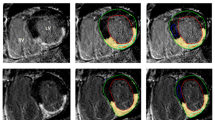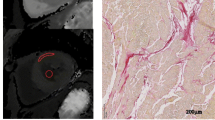Abstract
Background
The availability of a non-invasive test to detect and quantify interstitial and replacement fibrosis would be a useful advance for evaluation of cardiac therapies that could prevent fibrosis progression. There is an established role for magnetic resonance imaging (MRI) in the assessment of replacement fibrosis (when fibrosis replaces myocytes), but the potential for assessment of interstitial fibrosis (when amount of fibrosis increases between myocytes) has not been evaluated.
Methods
A novel in vitro MRI technique was developed for comparison of gadodiamide contrast distribution volume as a measure of both kinds of myocardial fibrosis, with histologically determined myocardial collagen volume fraction, the current gold standard for quantification of myocardial fibrosis. Eight samples of human myocardium were obtained postmortem and a fast spin-echo sequence (3 Tesla) with non-slice selective inversion pulse performed before and after immersion in a gadodiamide saline solution for determination of the gadodiamide partition coefficient. T1 values were calculated from the inversion recovery signal curves. The same samples were fixed in formalin, and collagen volume fraction was determined by the picrosirius red method using a semi-automated, polarized, digital microscopy system.
Results
Both gadodiamide distribution volumes as well as CVF values were significantly different in normal myocardium versus interstitial fibrosis (P = 0.001), and normal versus replacement fibrosis (P = 0.015). Moreover, there was a significant positive correlation between the two methods, across all three histological categories of myocardial fibrosis (r = 0.73; P = 0.017).
Conclusion
These findings indicate an expanded potential for gadodiamide enhanced MRI as a novel, non-invasive alternative to histological evaluation, for the quantification of both interstitial and replacement myocardial fibrosis.




Similar content being viewed by others
References
Hoyt RH, Ericksen E, Collins SM, Skorton DJ (1984) Computer-assisted quantitation of myocardial fibrosis in histologic sections. Arch Pathol Lab Med. 108(4):280–283
Hoyt RM, Skorton DJ, Collins SM, Melton HE Jr. (1984) Ultrasonic backscatter and collagen in normal ventricular myocardium. Circulation 69(4):775–782
Sweat F, Puchtler H, Rosenthal SI (1964) Sirius red F3ba as a stain for connective tissue. Arch Pathol 78:69–72
Whittaker P, Kloner RA, Boughner DR, Pickering JG (1994) Quantitative assessment of myocardial collagen with picrosirius red staining and circularly polarized light. Basic Res Cardiol 89(5):397–410
Kim RJ, Wu E, Rafael A, Chen EL, Parker MA, Simonetti O, Klocke FJ, Bonow RO, Judd RM (2000) The use of contrast-enhanced magnetic resonance imaging to identify reversible myocardial dysfunction. N Engl J Med 343(20):1445–1453
Kim RJ, Fieno DS, Parrish TB, Harris K, Chen EL, Simonetti O, Bundy J, Finn JP, Klocke FJ, Judd RM (1999) Relationship of MRI delayed contrast enhancement to irreversible injury, infarct age, and contractile function. Circulation 100(19):1992–2002
Hillenbrand HB, Becker LC, Kharrazian R, Hu K, Rochitte CE, Kim RJ, Chen EL, Ertl G, Hruban RH, Lima JA (2005) 23Na MRI combined with contrast-enhanced 1H MRI provides in vivo characterization of infarct healing. Magn Reson Med 53(4):843–850
Jerosch-Herold M, Sheridan D, Kushner JD, Nauman DJ, Burgess D, Dutton D, Hershberger RE (2006) Cardiac magnetic resonance contrast enhancement differentiates patients affected with familial dilated cardiomyopathy from asymptomatic relatives. J Cardiovasc Magn Reson 8(1):154–155
Schwarz F, Mall G, Zebe H, Blickle J, Derks H, Manthey J, Kubler W (1983) Quantitative morphologic findings of the myocardium in idiopathic dilated cardiomyopathy. Am J Cardiol 51(3):501–506
de Leeuw N, Ruiter DJ, Balk AH, de Jonge N, Melchers WJ, Galama JM (2001) Histopathologic findings in explanted heart tissue from patients with end-stage idiopathic dilated cardiomyopathy. Transpl Int 14(5):299–306
Rossi MA (1991) Patterns of myocardial fibrosis in idiopathic cardiomyopathies and chronic Chagasic cardiopathy. Can J Cardiol 7(7):287–294
Acknowledgements
MJH and SSC gratefully acknowledge support through R01 HL65394-02 from NIH and the Donald W. Reynolds Clinical Cardiovascular Research Center Grant to Johns Hopkins University, respectively.
Author information
Authors and Affiliations
Corresponding author
Rights and permissions
About this article
Cite this article
Kehr, E., Sono, M., Chugh, S.S. et al. Gadolinium-enhanced magnetic resonance imaging for detection and quantification of fibrosis in human myocardium in vitro. Int J Cardiovasc Imaging 24, 61–68 (2008). https://doi.org/10.1007/s10554-007-9223-y
Received:
Accepted:
Published:
Issue Date:
DOI: https://doi.org/10.1007/s10554-007-9223-y




